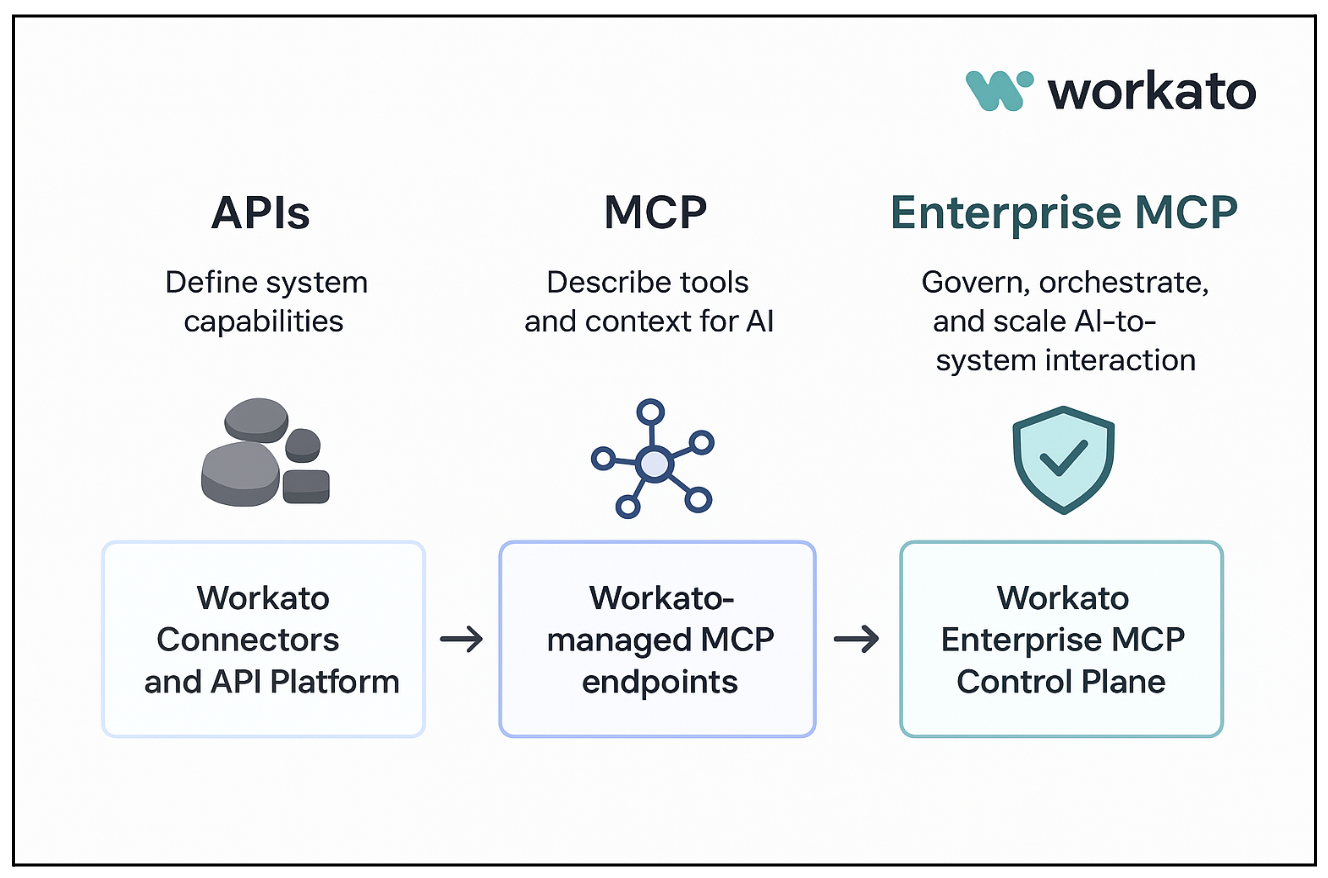For two decades, APIs have been the backbone of digital transformation. They gave enterprises a common language to connect applications, exchange data, and enable automation at scale. But as systems became more intelligent — infused with AI, event-driven triggers, and agentic capabilities — the API paradigm began to show its limits.
The rise of Model Context Protocol (MCP) marks a fundamental shift: from deterministic request–response integration to contextual, semantic, and adaptive orchestration. And now, as enterprises operationalize AI across their business systems, a new architectural layer is emerging — Enterprise MCP — bridging the gap between AI agents, enterprise data, and existing automation frameworks.

Let’s unpack this evolution.
1. APIs: The Language of Integration
APIs standardized how systems talk to each other.
They defined the “what” and “how” of integration — endpoints, parameters, and data formats — making it possible for developers to build interoperable ecosystems.
However, APIs are syntactic and procedural by nature. They expose functionality but not meaning.
Every integration still requires human understanding of what each endpoint represents, how data maps between systems, and how workflows should behave in context.
In the age of AI and multi-agent systems, this approach feels increasingly rigid. When a large language model (LLM) or agent wants to “understand” and “act” within an enterprise environment, the API alone doesn’t provide enough context.
APIs are the plumbing — necessary, but not sufficient — for intelligence.
2. MCP: From Syntax to Semantics
The Model Context Protocol (MCP) emerged to bridge that gap.
Originally proposed to help AI models access and act on structured data safely, MCP defines a standardized way to describe tools, data, and context so that language models can reason and interact with systems meaningfully.
Unlike APIs, which expose functions, MCP exposes intent and context.
It gives an LLM or agent a structured “map” of available tools, actions, and metadata — describing what can be done and under what rules.
This enables new kinds of integrations:
- LLMs can browse enterprise systems using metadata and schemas, not just fixed endpoints.
- Agentic systems can dynamically select actions based on context and permissions.
- Developers can publish capabilities once, allowing AI systems to discover and use them autonomously.
In short, MCP elevates integration from a procedural model to a semantic model — one that’s interpretable and adaptive by AI.
3. Enterprise MCP: The Operating Fabric for Intelligent Systems
While MCP is powerful, Enterprise MCP takes the concept further — from a developer protocol to a strategic enterprise architecture layer.
An Enterprise MCP doesn’t just let one agent talk to one model. It:
- Manages governance, observability, and security across all AI-to-system interactions.
- Enforces enterprise policies, such as data classification, access control, and compliance.
- Connects multiple MCP servers and domains, enabling agents to operate safely across business units, data platforms, and applications.
- Integrates natively with existing orchestration tools — like Workato, MuleSoft, or ServiceNow — to translate intent into action.
Think of Enterprise MCP as the control plane for intelligent connectivity.
It ensures every AI agent, integration, or workflow interacts with enterprise systems safely, contextually, and audibly — without breaking governance or compliance boundaries.
4. The Convergence: APIs, MCP, and Enterprise MCP Together
These three layers are not replacements for each other — they’re progressive abstractions:
| Layer | Purpose | Who Uses It | Example |
| APIs | Define functions and data exchange | Developers | “POST /orders” |
| MCP | Describe context and semantics for AI | AI agents, LLMs | “Order creation capability with customer schema” |
| Enterprise MCP | Govern, orchestrate, and secure AI + data access at scale | Enterprises, platforms | “Allow agents to create orders in ERP within finance domain, under compliance policy X” |
In this layered model:
- APIs remain the foundation — the executable endpoints.
- MCP provides semantic discovery and interaction.
- Enterprise MCP delivers control, trust, and scalability.
Together, they form the blueprint for the next generation of enterprise integration — one where APIs connect systems, MCP connects intelligence, and Enterprise MCP connects the enterprise itself.
5. The Strategic Opportunity
For enterprises, adopting an Enterprise MCP architecture means more than enabling AI agents.
It’s about future-proofing how systems, data, and intelligence interact.
The same way APIs powered the SaaS revolution, Enterprise MCP will power the AI-native enterprise — where humans, applications, and agents collaborate securely across shared data and context.
The leaders who recognize this early will define the next decade of digital transformation — not by building more APIs, but by orchestrating context, intent, and intelligence at scale.
Example: A Day in the Life of Enterprise MCP
Imagine a global finance team processing thousands of purchase orders across multiple ERPs, CRM systems, and procurement platforms. Today, employees:
- Pull reports manually from different systems.
- Validate orders against policies.
- Follow up with suppliers for missing approvals.
It’s time-consuming, error-prone, and reactive.
Now, imagine the same team using Enterprise MCP:
- AI agents understand context: Using MCP, AI knows the difference between an approved and a pending order, understands vendor hierarchies, and recognizes compliance rules.
- Automated orchestration: Enterprise MCP connects multiple AI agents across ERP, CRM, and procurement systems. The agent can automatically:
- Validate orders
- Apply business rules
- Flag exceptions for human review
- Governance and compliance baked in: Every action respects enterprise policies, access controls, and audit requirements.
The result? Orders move faster, errors drop, and employees focus on exceptions and strategic decisions—not repetitive tasks.
Closing Thought
APIs made systems talk.
MCP makes systems understand.
Enterprise MCP makes systems trustworthy and interoperable.
In that evolution lies the new foundation of enterprise connectivity — and the future of intelligent automation.
